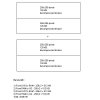Something that's been bothering me is that some sources are saying that the EE vector units run at half the EE clock speed (~147-150MHz), and that's what is currently written on Wikipedia. The PCSX2 emulator emulates CPU vs VU cycles by this ratio. But I doubt this is correct. I can't find any Sony sources that state this, only that the EE runs at ~300MHz, and while the user manuals don't mention absolute clock speed at all it seems like it'd be a massive omission to not indicate that the VUs run at half clock. Especially with VU0 in macro mode.
So, what is VU0 and VU1 clock speed, 150 Mhz or 300 Mhz?
I am pretty sure they were real time. I recall the character changed costumes in the cut scenes if you used alternative clothes
Thank you!


